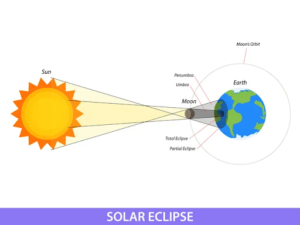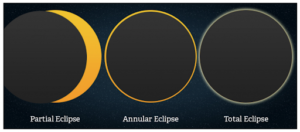
Total Solar Eclipse:
- A total solar eclipse, when the Moon completely blocks the Sun, creating daytime darkness, is a unique event for any given location on Earth, occurring approximately once every 400 years.
Solar Eclipses:
- Solar eclipses occur when the Moon positions itself between the Earth and the Sun, casting a shadow that darkens parts of the Earth.

Types of Solar Eclipses:
- Total Solar Eclipse: The Moon completely covers the Sun, revealing the Sun’s corona.
- Annular Solar Eclipse: The Moon covers the Sun’s center, leaving a visible outer ring, known as a “ring of fire.”
- Partial Solar Eclipse: The Moon obscures part of the Sun.
Frequency of Solar Eclipses:
- Solar eclipses can happen two to five times a year but are only visible from certain areas of the Earth due to the Moon’s tilted orbit.
Why Total Eclipses Are So Special:
- Total solar eclipses are particularly rare because they require being in the direct path of the Moon’s darkest shadow, or umbra, which covers a very small fraction of the Earth’s surface.
- Additionally, since much of the Earth’s surface is water or uninhabited land, witnessing a total solar eclipse is a special occurrence for those in the right location at the right time.
Why in News:
- A total solar eclipse which is a rare astronomical event, is about to be witnessed in North America.
 Profile
Profile Settings
Settings Refer your friends
Refer your friends Sign out
Sign out





